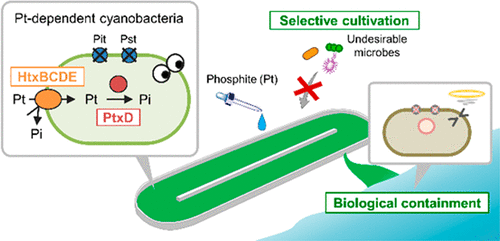当前位置:
X-MOL 学术
›
ACS Synth. Biol.
›
论文详情
Our official English website, www.x-mol.net, welcomes your
feedback! (Note: you will need to create a separate account there.)
Synthetic Phosphorus Metabolic Pathway for Biosafety and Contamination Management of Cyanobacterial Cultivation
ACS Synthetic Biology ( IF 3.7 ) Pub Date : 2018-09-11 00:00:00 , DOI: 10.1021/acssynbio.8b00199 Kei Motomura 1, 2 , Kosuke Sano 1 , Satoru Watanabe 2, 3 , Akihiro Kanbara 1 , Abdel-Hady Gamal Nasser 1 , Takeshi Ikeda 1 , Takenori Ishida 1 , Hisakage Funabashi 1 , Akio Kuroda 1, 2 , Ryuichi Hirota 1, 2
ACS Synthetic Biology ( IF 3.7 ) Pub Date : 2018-09-11 00:00:00 , DOI: 10.1021/acssynbio.8b00199 Kei Motomura 1, 2 , Kosuke Sano 1 , Satoru Watanabe 2, 3 , Akihiro Kanbara 1 , Abdel-Hady Gamal Nasser 1 , Takeshi Ikeda 1 , Takenori Ishida 1 , Hisakage Funabashi 1 , Akio Kuroda 1, 2 , Ryuichi Hirota 1, 2
Affiliation

|
Recent progress in genetic engineering and synthetic biology have greatly expanded the production capabilities of cyanobacteria, but concerns regarding biosafety issues and the risk of contamination of cultures in outdoor culture conditions remain to be resolved. With this dual goal in mind, we applied the recently established biological containment strategy based on phosphite (H3PO3, Pt) dependency to the model cyanobacterium Synechococcus elongatus PCC 7942 (Syn 7942). Pt assimilation capability was conferred on Syn 7942 by the introduction of Pt dehydrogenase (PtxD) and hypophosphite transporter (HtxBCDE) genes that allow the uptake of Pt, but not phosphate (H3PO4, Pi). We then identified and disrupted the two indigenous Pi transporters, pst (Synpcc7942_2441 to 2445) and pit (Synpcc7942_0184). The resultant strain failed to grow on any media containing various types of P compounds other than Pt. The strain did not yield any escape mutants for at least 28 days with a detection limit of 3.6 × 10–11 per colony forming unit, and rapidly lost viability in the absence of Pt. Moreover, growth competition of the Pt-dependent strain with wild-type cyanobacteria revealed that the Pt-dependent strain could dominate in cultures containing Pt as the sole P source. Because Pt is rarely available in aquatic environments this strategy can contribute to both biosafety and contamination management of genetically engineered cyanobacteria.
中文翻译:

合成磷代谢途径对蓝藻培养的生物安全性和污染管理的影响
基因工程和合成生物学的最新进展极大地扩展了蓝细菌的生产能力,但是有关生物安全性问题以及户外培养条件下培养物污染风险的担忧仍有待解决。考虑到这个双重目标,我们将最近建立的基于亚磷酸酯(H 3 PO 3,Pt)依赖性的生物遏制策略应用于模型蓝藻长形突触球菌PCC 7942(Syn 7942)。通过引入Pt脱氢酶(PtxD)和次磷酸盐转运蛋白(HtxBCDE)基因,可以吸收Pt而不吸收磷酸盐(H 3 PO 4),从而在Syn 7942上赋予了Pt同化能力。,Pi)。然后,我们确定并破坏了两个本地Pi转运蛋白pst(Synpcc7942_2441至2445)和坑(Synpcc7942_0184)。所得菌株无法在含有除Pt以外的各种P化合物的任何培养基上生长。该菌株至少28天未产生任何逃逸突变体,检出限为3.6×10 –11每个菌落形成单位,并在缺乏铂的情况下迅速丧失生存力。此外,Pt依赖菌株与野生型蓝细菌的竞争竞争表明,Pt依赖菌株可以在含有Pt作为唯一P源的培养物中占主导地位。由于Pt在水生环境中很少可利用,因此该策略可有助于基因工程蓝细菌的生物安全性和污染管理。
更新日期:2018-09-11
中文翻译:

合成磷代谢途径对蓝藻培养的生物安全性和污染管理的影响
基因工程和合成生物学的最新进展极大地扩展了蓝细菌的生产能力,但是有关生物安全性问题以及户外培养条件下培养物污染风险的担忧仍有待解决。考虑到这个双重目标,我们将最近建立的基于亚磷酸酯(H 3 PO 3,Pt)依赖性的生物遏制策略应用于模型蓝藻长形突触球菌PCC 7942(Syn 7942)。通过引入Pt脱氢酶(PtxD)和次磷酸盐转运蛋白(HtxBCDE)基因,可以吸收Pt而不吸收磷酸盐(H 3 PO 4),从而在Syn 7942上赋予了Pt同化能力。,Pi)。然后,我们确定并破坏了两个本地Pi转运蛋白pst(Synpcc7942_2441至2445)和坑(Synpcc7942_0184)。所得菌株无法在含有除Pt以外的各种P化合物的任何培养基上生长。该菌株至少28天未产生任何逃逸突变体,检出限为3.6×10 –11每个菌落形成单位,并在缺乏铂的情况下迅速丧失生存力。此外,Pt依赖菌株与野生型蓝细菌的竞争竞争表明,Pt依赖菌株可以在含有Pt作为唯一P源的培养物中占主导地位。由于Pt在水生环境中很少可利用,因此该策略可有助于基因工程蓝细菌的生物安全性和污染管理。











































 京公网安备 11010802027423号
京公网安备 11010802027423号